With first cut nearing sight, it’s important grass machinery is at the ready once the weather window arrives. So, now is the time if not already done to pull the forage wagon out of the shed and give it a run through in order to avoid finding an unwanted issue just as silage starts.
We met with Adam Kinkade from longstanding Pöttinger dealer Kinkade’s Garage based in Cavan near the Monaghan border to go through a typical used forage wagon ahead of the season.
Although machines may differ slightly between brands, the basic maintenance principles remain the same. The unit we looked at was a 2008 Pöttinger Faro 4000.
Towing eye and pto shaft
Starting at the front of the machine, Adam insists on inspecting the towing eye for wear and that its bolts are tight. The wide angle shaft then should be greased and checked that it’s moving freely through all motions. On the other end of the shaft is the slip clutch, which should be checked to ensure it’s not seized or incorrectly set. An incorrectly set or seized slip clutch will either slip prematurely or not slip at the required force, potentially causing harm to the main gearbox or the wagon’s drivetrain.
Pickup and rotor
The heart of any forage wagon is its pickup, rotor and knife bank. This is where the bulk of the typical pre-season maintenance inspections takes place. Adam recommends to start by checking the cam bearings and cam track for play and wear.
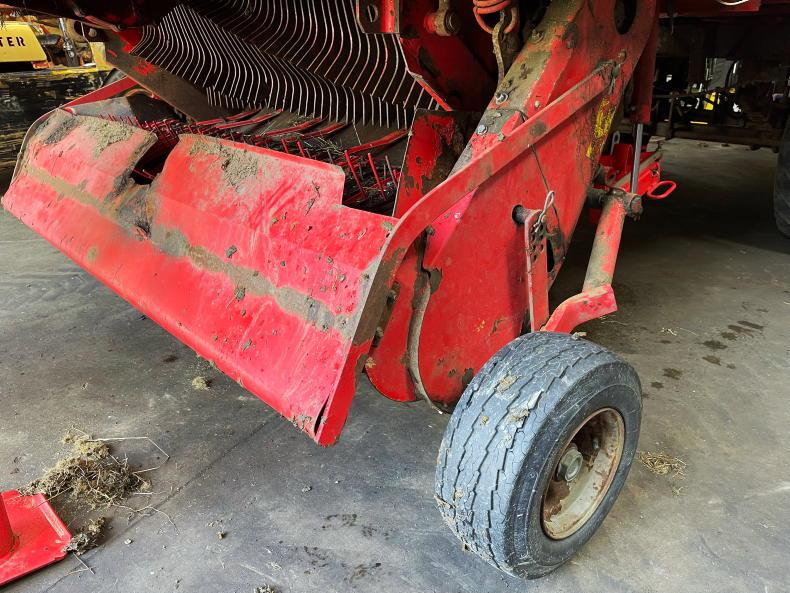
Pickup cam bearings should be checked so too should the pickups end bearings.
He said: “Depending on use and the operator, cam bearings should last between two and three seasons. The majority of Pöttinger machines are fitted with a six-tine bar pickup aside from some Jumbo models which have seven- and eight-tine bars, so therefore have the same number of cam bearings on either side of the reel. By removing the side plate and rotating the tine bars, access can be gained to each bearing. It’s not uncommon to look in here and find that bearings are disintegrated. Replacement bearings will cost in the region of €30 plus VAT each.”
Camless pickups still need to be inspected for wear which can be more common as the pickup tends to turn much faster. The end bearings on either side of the pickup will also need to be checked for play.
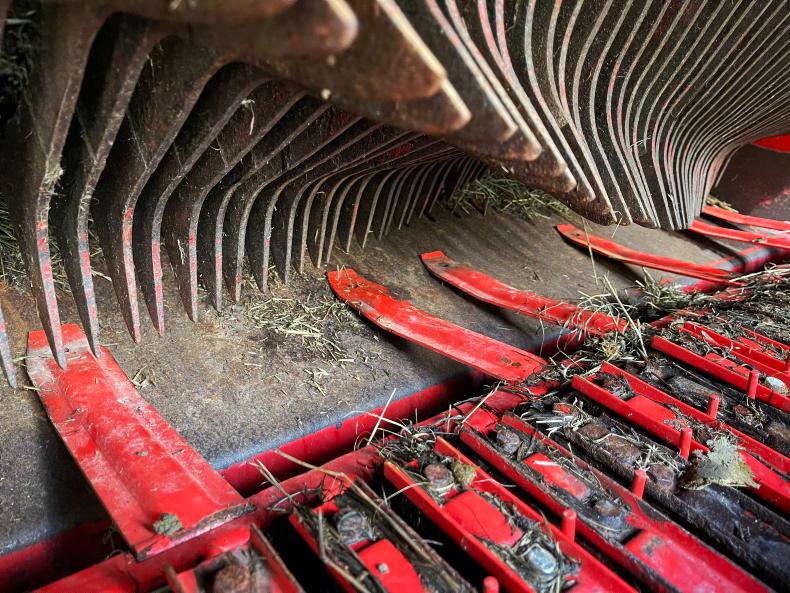
Missing transfer plates as photographed can lead to short grass falling down between the pickup and rotor.
“Aside from this it’s a matter of ensuring all tines and pickup bands are intact and tight. Tines can come loose, especially if spurious lock nuts and washers are used. If the pickup wheels are incorrectly set or underinflated tines can become bent and start rubbing/get caught behind the bands. Ensure bent tines are replaced,” Adam explained.
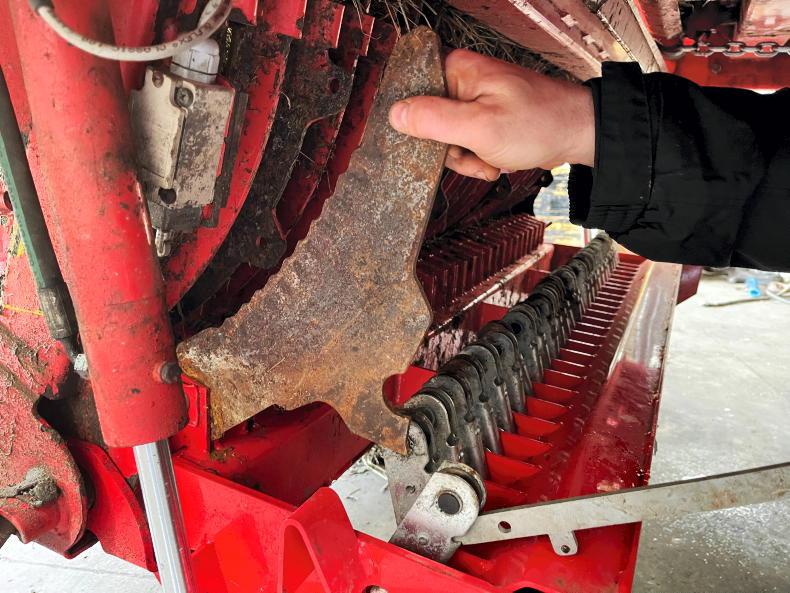
Each individual knife lever and roller wheel should be free moving.
“The transfer plates between the pickup and the rotor should all be present and replaced if not. Missing transfer plates can result in short grass falling through the gap between the pickup and rotor. Although transfer plates vary between models, they typically cost in the region of €35 plus VAT each.
“There are two areas to check on the rotor mainly, the first being the large bearing at either end and secondly that each of the individual knife scrapers are in position and secure. This is a particular area overlooked. If seen in time, a loose scraper finger may just need resetting or if worn need replaced or built back up with a weld and ground down. Scrapers that come loose or are very worn will over time drop down and score the rotor, eventually cutting through its main tubular section. In the unlucky event that this happens, the rotor may be able to be re-sleeved or in the worst-case scenario it may need replaced.”
Chopping unit
The knife bank will vary between brands and models. However, most modern machines have a swingout or pullout knife bank. Adam noted that the key point here is to ensure all knives can retract freely in the event of a foreign object making its way through the machine. Each knife is individually protected by a retaining spring and knife lever with roller wheel. Each wheel and knife lever should be free-moving and straight so that the blade can retract at the correct pressure.

Knife scraper fingers can be reset directly above the rotor on the exterior of the machine.
Adam said the particular Faro 4000 in question had been recently fitted with a new knife bank as it worked out cheaper than replacing the majority of roller wheels and knife levers individually.
“My advice would be to blow down and remove each knife from the bank and oil the entire unit after use if the machine is going to be parked up for any length of time. This way nothing will have seized when you come back,” Adam said.
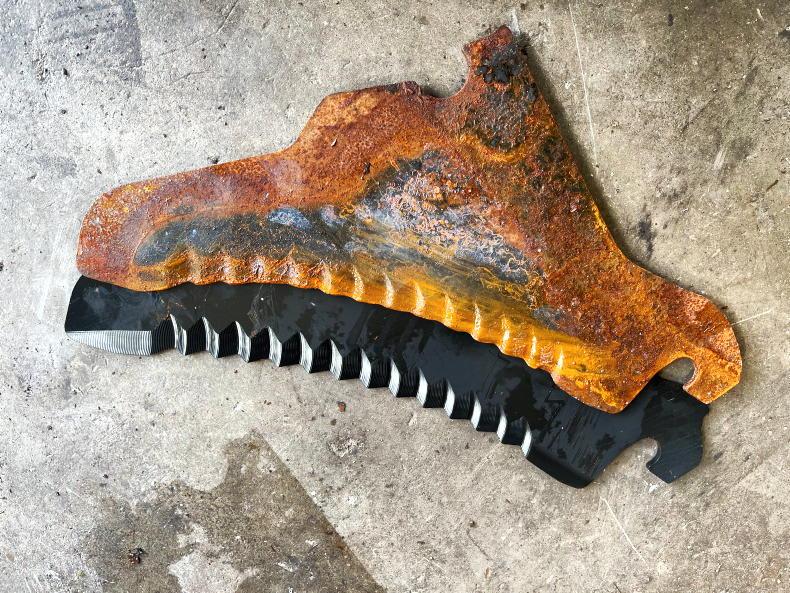
Worn knives should be replaced.
Knives should be sharpened regularly and replaced if worn to the extent that the serrated edge is gone. A set of genuine single-sided Pöttinger knives for this particular machine will cost €30 plus VAT each.
Gearboxes and chains
Depending on the particular model the wagon will either be chain driven or gearbox driven. Smaller chain driven wagons will need to have the main drive chain inspected for wear and that it is correctly tensioned. Aside from this, ensure the chain lube system is working correctly and lubricating the chain sufficiently.
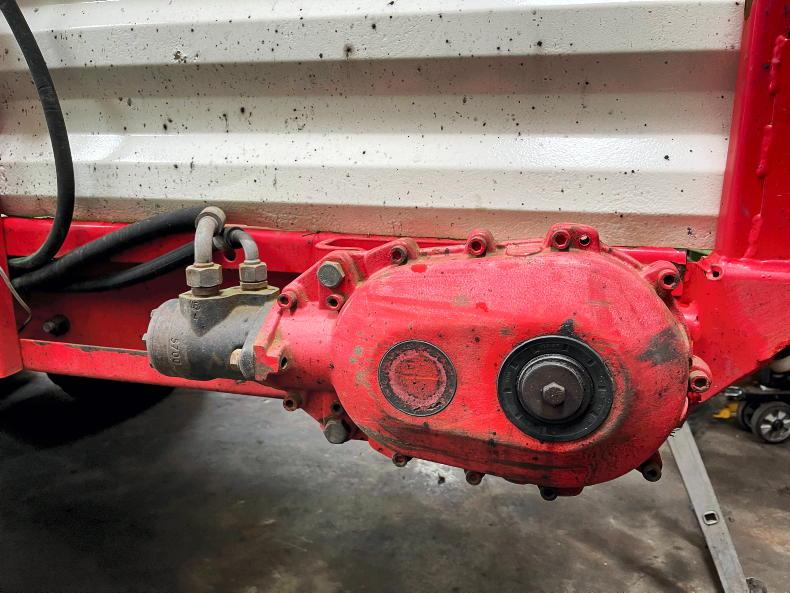
All gearboxes should have their oil level checked and replaced if necessary.
Larger machines fitted with gearboxes should have their oil level inspected and ideally replaced annually depending on usage. If oil is milky it will need to be replaced and a further inspection for water ingress will be needed. If metal filings are present, a gear is likely damaged. Adam recommends having a dealer take a further look.
The rear floor drive gearbox oil level should be checked and oil quality inspected too.
Floor chains and rear door
“It’s normal for floor chains to wear so it’s important the degree of tension is checked quite frequently. What feels tight at the start of the season may in fact not be tight after a few loads,” Adam explained.
The Faro 4000 we looked at was fitted with a large single slat and two chains as opposed to twin slats and four chains. Adam said it is critically important chains are tensioned evenly on either side.
If the tensioners are out to their limit but the chain is still not tight then an even number of link(s) will need to be removed on either side. A correctly tensioned chain should sag ever so slightly. The joining links should be checked that all split pins are intact.

Both floor slats and timbers should be checked and in good order.
Both floor slats and floor timbers should be checked. Bent slats will need to be straightened or replaced. The rear door should close correctly and engage the door sensor. Check and address any possible ram seal leaks as this can result in pressure losses.
Chassis and running gear
The chassis and running gear should be examined for fatigue or signs of wear. Adam advises checking brakes and wheel bearings as well as spring condition, paying particular attention for broken leafs and that U bolts are tight.
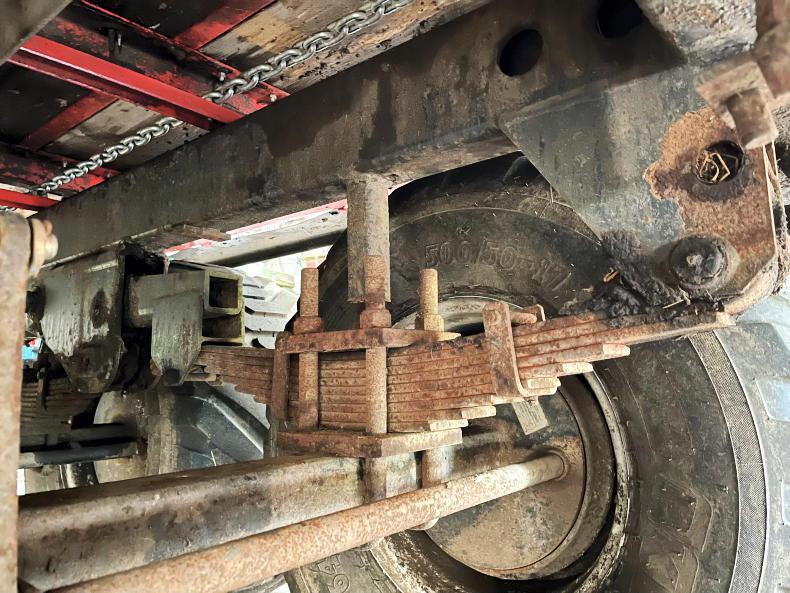
Running gear including springs and brakes should all be inspected.
Machines with steering axles need to be greased regularly given their number of moving parts. Wear will result in unwanted movement within the axle. Adam also said that it is critically important steering axles lock for road transport.
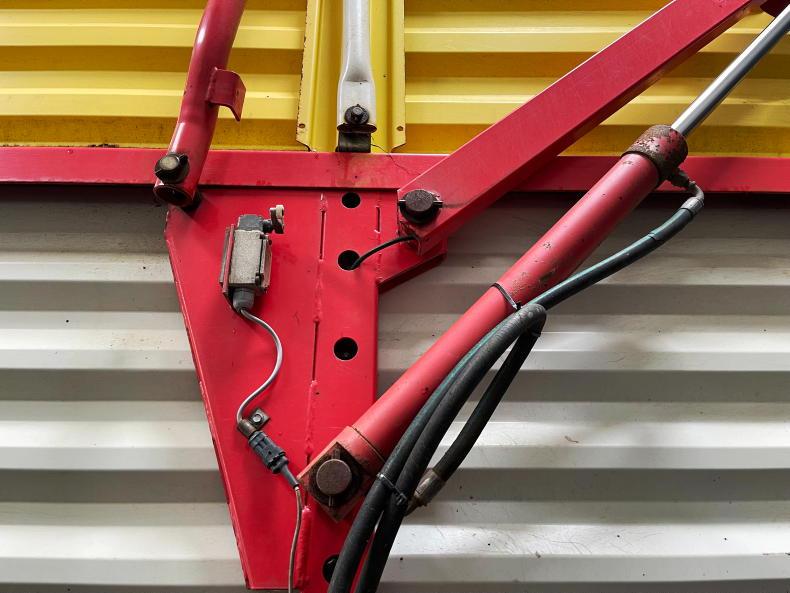
Sensors should be functional and ram seals checked for leaks.
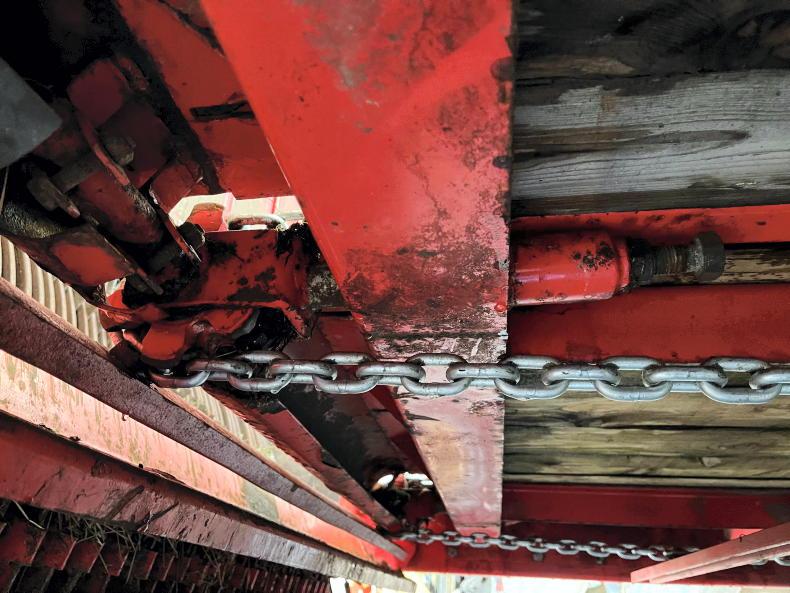
Floor chains adjusters are located right behind the pickup.
Control box and sensors
If dry stored and out of the way of pests, control boxes and electrical connections should be in working order. Inspect the load-sensing valve block for leaks. Finally, spend some time operating the machine empty before heading to the field to ensure sensors and functions such as auto load are working as they should. Some higher spec control boxes modern control boxes work off a can-bus system which alarms when a sensor is damaged or faulty. Our final advice would be to clean down and spray the machine with an oil/diesel mixture and park under a roof where at all possible come the end of each season. The correct clean down and dry storage will improve the lifespan of any machine and reduce the annual running costs.
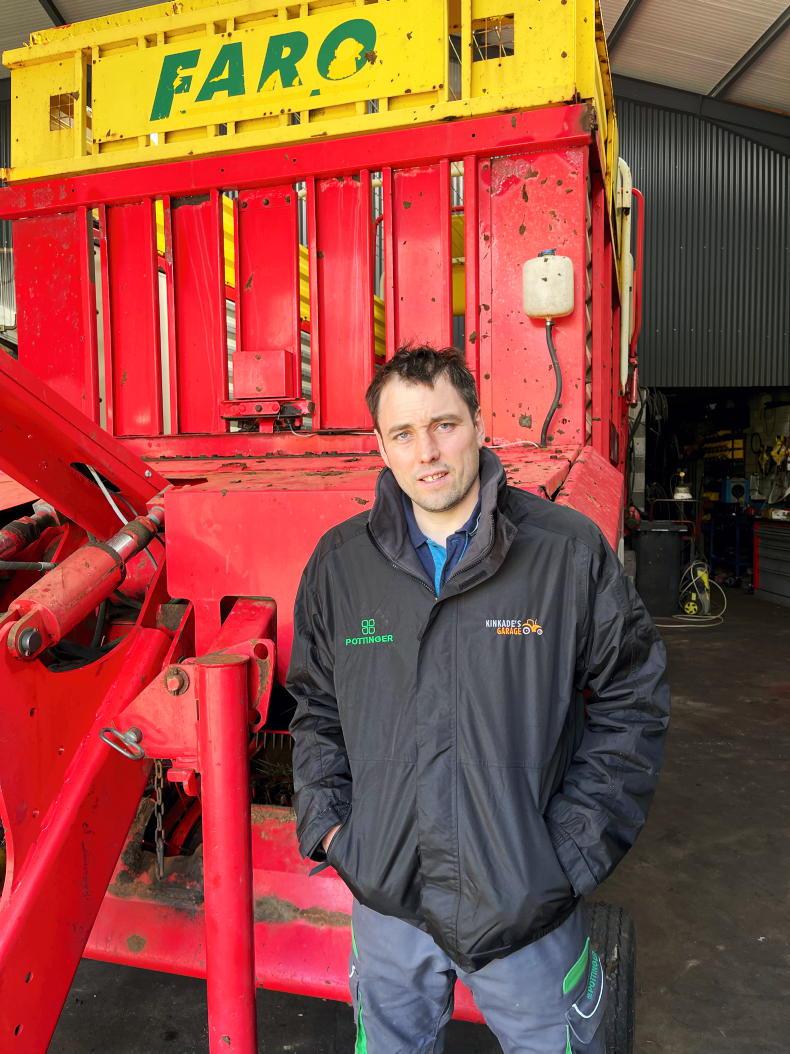
Adam Kinkade, Kinkades Garage.
With first cut nearing sight, it’s important grass machinery is at the ready once the weather window arrives. So, now is the time if not already done to pull the forage wagon out of the shed and give it a run through in order to avoid finding an unwanted issue just as silage starts.
We met with Adam Kinkade from longstanding Pöttinger dealer Kinkade’s Garage based in Cavan near the Monaghan border to go through a typical used forage wagon ahead of the season.
Although machines may differ slightly between brands, the basic maintenance principles remain the same. The unit we looked at was a 2008 Pöttinger Faro 4000.
Towing eye and pto shaft
Starting at the front of the machine, Adam insists on inspecting the towing eye for wear and that its bolts are tight. The wide angle shaft then should be greased and checked that it’s moving freely through all motions. On the other end of the shaft is the slip clutch, which should be checked to ensure it’s not seized or incorrectly set. An incorrectly set or seized slip clutch will either slip prematurely or not slip at the required force, potentially causing harm to the main gearbox or the wagon’s drivetrain.
Pickup and rotor
The heart of any forage wagon is its pickup, rotor and knife bank. This is where the bulk of the typical pre-season maintenance inspections takes place. Adam recommends to start by checking the cam bearings and cam track for play and wear.

Pickup cam bearings should be checked so too should the pickups end bearings.
He said: “Depending on use and the operator, cam bearings should last between two and three seasons. The majority of Pöttinger machines are fitted with a six-tine bar pickup aside from some Jumbo models which have seven- and eight-tine bars, so therefore have the same number of cam bearings on either side of the reel. By removing the side plate and rotating the tine bars, access can be gained to each bearing. It’s not uncommon to look in here and find that bearings are disintegrated. Replacement bearings will cost in the region of €30 plus VAT each.”
Camless pickups still need to be inspected for wear which can be more common as the pickup tends to turn much faster. The end bearings on either side of the pickup will also need to be checked for play.

Missing transfer plates as photographed can lead to short grass falling down between the pickup and rotor.
“Aside from this it’s a matter of ensuring all tines and pickup bands are intact and tight. Tines can come loose, especially if spurious lock nuts and washers are used. If the pickup wheels are incorrectly set or underinflated tines can become bent and start rubbing/get caught behind the bands. Ensure bent tines are replaced,” Adam explained.

Each individual knife lever and roller wheel should be free moving.
“The transfer plates between the pickup and the rotor should all be present and replaced if not. Missing transfer plates can result in short grass falling through the gap between the pickup and rotor. Although transfer plates vary between models, they typically cost in the region of €35 plus VAT each.
“There are two areas to check on the rotor mainly, the first being the large bearing at either end and secondly that each of the individual knife scrapers are in position and secure. This is a particular area overlooked. If seen in time, a loose scraper finger may just need resetting or if worn need replaced or built back up with a weld and ground down. Scrapers that come loose or are very worn will over time drop down and score the rotor, eventually cutting through its main tubular section. In the unlucky event that this happens, the rotor may be able to be re-sleeved or in the worst-case scenario it may need replaced.”
Chopping unit
The knife bank will vary between brands and models. However, most modern machines have a swingout or pullout knife bank. Adam noted that the key point here is to ensure all knives can retract freely in the event of a foreign object making its way through the machine. Each knife is individually protected by a retaining spring and knife lever with roller wheel. Each wheel and knife lever should be free-moving and straight so that the blade can retract at the correct pressure.

Knife scraper fingers can be reset directly above the rotor on the exterior of the machine.
Adam said the particular Faro 4000 in question had been recently fitted with a new knife bank as it worked out cheaper than replacing the majority of roller wheels and knife levers individually.
“My advice would be to blow down and remove each knife from the bank and oil the entire unit after use if the machine is going to be parked up for any length of time. This way nothing will have seized when you come back,” Adam said.

Worn knives should be replaced.
Knives should be sharpened regularly and replaced if worn to the extent that the serrated edge is gone. A set of genuine single-sided Pöttinger knives for this particular machine will cost €30 plus VAT each.
Gearboxes and chains
Depending on the particular model the wagon will either be chain driven or gearbox driven. Smaller chain driven wagons will need to have the main drive chain inspected for wear and that it is correctly tensioned. Aside from this, ensure the chain lube system is working correctly and lubricating the chain sufficiently.

All gearboxes should have their oil level checked and replaced if necessary.
Larger machines fitted with gearboxes should have their oil level inspected and ideally replaced annually depending on usage. If oil is milky it will need to be replaced and a further inspection for water ingress will be needed. If metal filings are present, a gear is likely damaged. Adam recommends having a dealer take a further look.
The rear floor drive gearbox oil level should be checked and oil quality inspected too.
Floor chains and rear door
“It’s normal for floor chains to wear so it’s important the degree of tension is checked quite frequently. What feels tight at the start of the season may in fact not be tight after a few loads,” Adam explained.
The Faro 4000 we looked at was fitted with a large single slat and two chains as opposed to twin slats and four chains. Adam said it is critically important chains are tensioned evenly on either side.
If the tensioners are out to their limit but the chain is still not tight then an even number of link(s) will need to be removed on either side. A correctly tensioned chain should sag ever so slightly. The joining links should be checked that all split pins are intact.

Both floor slats and timbers should be checked and in good order.
Both floor slats and floor timbers should be checked. Bent slats will need to be straightened or replaced. The rear door should close correctly and engage the door sensor. Check and address any possible ram seal leaks as this can result in pressure losses.
Chassis and running gear
The chassis and running gear should be examined for fatigue or signs of wear. Adam advises checking brakes and wheel bearings as well as spring condition, paying particular attention for broken leafs and that U bolts are tight.

Running gear including springs and brakes should all be inspected.
Machines with steering axles need to be greased regularly given their number of moving parts. Wear will result in unwanted movement within the axle. Adam also said that it is critically important steering axles lock for road transport.

Sensors should be functional and ram seals checked for leaks.

Floor chains adjusters are located right behind the pickup.
Control box and sensors
If dry stored and out of the way of pests, control boxes and electrical connections should be in working order. Inspect the load-sensing valve block for leaks. Finally, spend some time operating the machine empty before heading to the field to ensure sensors and functions such as auto load are working as they should. Some higher spec control boxes modern control boxes work off a can-bus system which alarms when a sensor is damaged or faulty. Our final advice would be to clean down and spray the machine with an oil/diesel mixture and park under a roof where at all possible come the end of each season. The correct clean down and dry storage will improve the lifespan of any machine and reduce the annual running costs.

Adam Kinkade, Kinkades Garage.

















 This is a subscriber-only article
This is a subscriber-only article











SHARING OPTIONS: